Evaluating Competencies
Performance is not solely about attaining targets; how they are achieved also matters. For example, an organization's best salesperson may bring in the most revenue, but if he or she communicates poorly with others within the organization then the first experience of working with new customers could be fraught with misunderstandings.
These could have been avoided if the salesperson behaved differently, i.e. worked as a team player, provided the implementation team with supporting documents, and communicated the customer's requirements properly. By doing these things, the salesperson could ensure that the customer's expectations were met and that the customer's first experiences with service delivery were good ones.
 |
There are two ways you can gather performance data on the competencies of your team members: firstly, by recording details of significant incidents involving the individual; and secondly by actually observing the behaviors they display.
So, how do you define a significant incident? As part of your role in managing your team's performance you will regularly be analyzing the report data each individual sends you. This information along with each person's goals enable you to have a defined expectation of what is required, what needs to be done, and what constitutes successful completion. An incident becomes 'significant' when the performance or behaviors of the individual deviate substantially from your expectations.
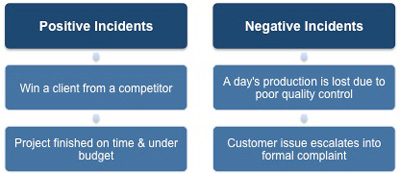 |
These incidents are relatively rare and they are significant because each one provides you with evidence of how well, or not, the person's competencies and behaviors match those expected of their role.
In addition to noting these, you should observe each team member's day-to-day interactions with others. You then need to evaluate what you see in terms of whether or not it meets expected performance levels. For example, does the individual go out of their way to help other team members or voluntarily take on additional responsibilities? Conversely, do you ever see them being obstructive, withholding knowledge, or claiming credit for someone else's work?
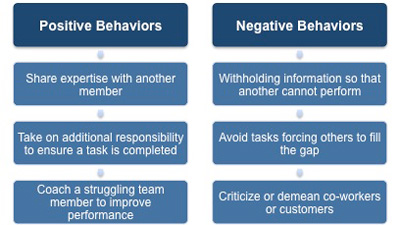 |
As described earlier, competencies are the aggregate behaviors needed for an individual to perform their role. They relate to how people deliver objectives rather than to what the objectives are. These are detailed in a person's job description and specification, and this will help you in your weighting of each one in its contribution to the team member's performance.
For example, a salesperson needs to display a team-working competency so that orders are fulfilled as promised. They also need to be customer focused and consider the customer's long-term needs so that the customer continues to return to the organization for future services, not just the initial purchase.
The relative importance placed on each desired competency will reflect the culture and values of the organization and the behavior exhibited by senior management.
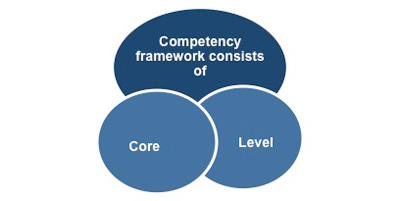 |
Some competencies may be defined as 'core.' These apply to all employees, whilst others, such as leadership, may only be appropriate to a 'level' or grade, e.g. managers. These different levels and their associated competencies and associated behaviors make up an organization's competency framework. The typical competencies included in a framework are:
• Communicating Effectively
• Planning and Organizing
• Leadership
• Teamwork
• Creativity
• Focus on Goals
• Embracing Change
Evaluating Competencies Example
In this example, you want to gather performance data on your team's competency level for 'communicating effectively.' The first step is to refer to your organization's competency framework and definitions. This is usually available from your human resources (HR) department.
In this example, the organization has defined the competency 'communicating effectively' and its minimum requirements for each of three levels. Each level builds on the preceding one and so clearly illustrates any gaps an individual needs to fill, or enhancement they need to make, in order to perform more effectively.
You role as manager is to ensure that all your members are operating at Level 3 and to show evidence of these behaviors.
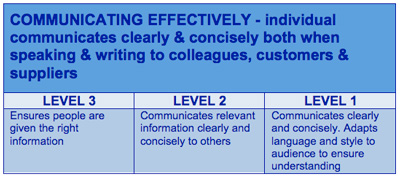 |
The broad explanations at each level are further broken down into the expected behaviors you can measure their performance against. This breakdown shows the development in the competency as the person moves up a level.
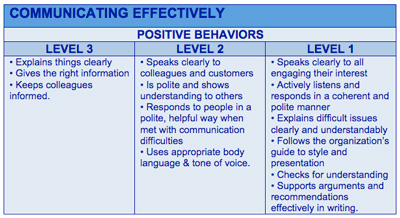 |
Armed with this list you can now actively observe your team's performance and daily activities, noting examples of each behavior.
Some organizations also include a list of negative behaviors for each level but this is not the norm. This may be something that your human resources department asks you to observe and note if there is a disciplinary issue with an individual.
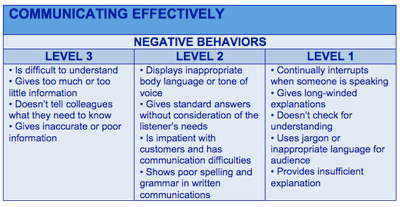 |
Using this framework you can easily create a spreadsheet for each member to help you record your observations of each person demonstrating these behaviors, and so define the level they are at. The performance management data gathered throughout the review period provides you with a list of incidents and observations of each team member's behaviors.
A well-designed competency framework helps you conduct effective appraisals and define training requirements as well as areas for coaching and career development. The framework can also be a useful tool when recruiting new members for your team. If you want to learn more about competencies download free our eBook 'Developing Competencies.'
You may also be interested in:
Evaluating Performance Appraisal | Appraisal Data Collection | Performance Appraisal Rating Bias | Performance Appraisal Rating Scales | Performance Appraisal Reviews | Writing an Annual Performance Summary.



